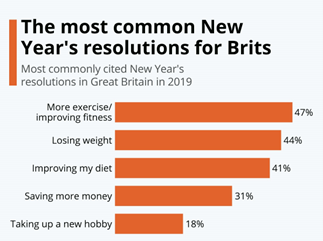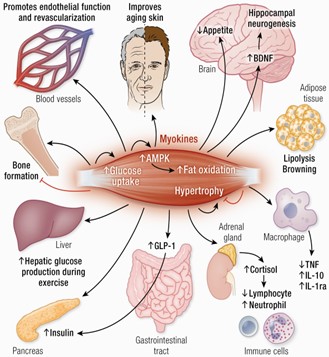New Research Reveals Unexpected Exercise Benefits!
Posted by Phil Heler on December 31, 2023Skeletal muscles secrete powerful hormones called myokines. These allow skeletal muscle to interact and influence other organs such as the brain, bone, liver, digestive tract, pancreas, vascular system.
Despite food inflation and the cost-of-living crisis I am sure we will all make an exception for Christmas. After all as Oscar Wilde once said, ‘After a good dinner, one can forgive anybody, even one’s own relatives.’ We will still gather with friends and family as we partake in our annual gastronomic extravaganza.
Whoever said ‘calories don’t count at Christmas’ may have been a little optimistic as evidence points to the contrary. The haze of overindulgence when coupled with less movement during colder days, leaves us feeling both lethargic and sluggish, and in need of a change. That’s when we traditionally think of a reset point. Hence a new year’s resolution.
For the fitness industry this is boom time. In the UK our biggest gym operator is PureGym. They have 327 gyms with more than 1.5 million members. In January 2023 their gyms were almost 40% busier. Parkrun which has 1,233 outdoor running events in the UK had twice as many registrations in January 2023 (total of 50,000) compared with the previous month.
As a general observation it would also seem that we are struggling to regain our pre-pandemic activity levels. The cost-of-living crisis means we are cutting corners on healthy eating. As a cost-cutting measure gym memberships also perhaps come under scrutiny.
This year a government report suggested that we Brits now suffer from ‘stubbornly high levels of inactivity’. According to Sport and Recreational Alliance (an umbrella body for sport and recreation in the UK) we now rank joint 12th out of 15 comparable European nations for levels of physical activity. The shame continues.
A quarter of adults are now deemed to be inactive in England. There are more than 11 million of us doing less than half an hour’s total activity in a week. More than half of our children and young people do not even reach the Chief Medical Officer’s (Professor Chris Whitty) guidance of at least 60 minutes of activity a day – with 30% doing less than 30 minutes a day.
We all know that exercise has a significant cardiovascular benefit and of course burns those unwanted calories. But there are other hidden benefits. In the past decade there has been a huge increase in research which looks at how good exercise is for optimising brain function and health. The phrase ‘what is good for the body is good for the brain’, as evidence mounts, is literally true. Research is now beginning to unravel the mechanisms and reasons for this phenomenon.
Our brains have an unquenchable thirst for energy. They are ravenous beasts that need feeding just like our young Labrador. A brain is 2% of your total body weight (at @1.3-1.4kg) but demands 20% of your calories. It has a continuous demand for energy, needs a constant supply of oxygen and a whole suite of nutrients.
All this is of course delivered through the vascular system. This is where exercise plays its part. It makes your heart a better pump. Studies have shown that the wall thickness of the left ventricle in the heart increases by 15% and cavity dimension by 10% with even just a moderate increase in activity.
The left ventricle pumps oxygenated blood so that our body tissues, including the brain, are well perfused. But the heart muscle is not the only type of muscle that benefits.
We might assume that our skeletal muscles are just passive structures that respond to commands when we need to run, walk, throw, or jump. But you couldn’t be more wrong. It has slowly become apparent over the last decade that skeletal muscles generate chemical messengers as you exercise.
They have a key role as an endocrine organ that secretes powerful hormones. These hormones are called myokines. These allow skeletal muscle to interact and influence other organs such as the brain, bone, liver, digestive tract, pancreas, vascular system and within the muscles themselves.
Only roughly 5% of myokines have thus far been described so it really is a new science. We do know that myokines also have additional roles in cognition, bone formation, skin structure, fat and glucose metabolism and bone formation. Many of the potent cocktail of myokines also targets our central nervous system (or brain). This might help explain the origins of ‘a healthy body leads to a healthy mind’.
This is literally true because exercise stimulates the growth of new brain cells. This is because it stimulates the production of brain-derived neurotrophic factor (BDNF). According to one study from 2008 physical activity stimulates neurogenesis (new brain cells) in a part of the brain called dentate gyrus which is in the hippocampus.
This brain area is important for learning and memory. New hippocampal neurons may be partially responsible for improved learning response that is associated with exercise. This is significant because dementia and various other mental conditions have the opposite effect by causing a lack of new cell growth. So, exercise may help mitigate this effect.
The question remains, exactly what type of exercise would be the most beneficial. A paper published in August 2022 entitled ‘The Effect of Exercise on Neurogenesis in the Brain’ looked at precisely that. The researchers chose to look at aerobic, anaerobic, and resistance exercise and assessed their impact on brain plasticity and cognitive function.
It is known that all three of these exercise modalities have a positive effect although via different pathways. They also manipulated exercise intensity, volume, and rest intervals for each exercise type.
The benefits of aerobic and anaerobic exercise are known to be primarily mediated by changes in expression of BDNF and another hormone called vascular endothelial growth factor (VEGF), and several additional proteins within the brain. Resistance exercise meanwhile works in a different way by influencing brain plasticity via other myokines including irisin, insulin-growth factor-1 (IGF1), as well as BDNF.
High Intensity Interval training (HIIT) maximises both aerobic and anaerobic fitness. The researchers concluded that HIIT training appeared to offer greater cognitive improvements than lower intensity aerobic exercise. Strikingly, strength training seemed to result in a greater variety of myokines being released from muscles. One of these, insulin growth factor 1, enhances the growth and survival of neurons, and has been linked with cognitive performance. Another, irisin, is often reduced when people suffer from Alzheimer’s.
In general terms research appears to indicate that any exercise can cause long term structural and functional changes. Improvements help different parts of the brain to communicate, allowing people to access and process information more quickly. Any exercise will help stimulate some level of improvement. So perhaps if you are one of 47% of people who choose exercise as a new year’s resolution this article might give you a bit more inspiration.



